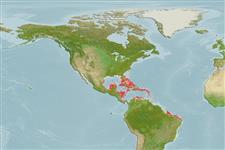Common names from other countries
Bivalvia |
Cardiida |
Tellinidae
Environment: milieu / climate zone / εύρος βάθους / distribution range
Οικολογία
; εύρος βάθους 0 - 18 m (Αναφ. 83435). Tropical
Western Central Atlantic: USA.
Length at first maturity / Μέγεθος / Weight / Age
Γεννητική Ωρίμανση: Lm ? range ? - ? cm Max length : 2.6 cm DL αρσενικό/απροσδιόριστο; (Αναφ. 83435)
Intertidal (Ref. 104365).
Life cycle and mating behavior
Γεννητική Ωρίμανση | Αναπαραγωγή | Γεννοβολία | Eggs | Γονιμότητα | Larvae
Members of the class Bivalvia are mostly gonochoric, some are protandric hermaphrodites. Life cycle: Embryos develop into free-swimming trocophore larvae, succeeded by the bivalve veliger, resembling a miniature clam.
Bieler, R. and P.M. Mikkelsen. 2004. (Αναφ. 8163)
IUCN Red List Status
(Αναφ. 130435: Version 2025-1)
CITES status (Αναφ. 108899)
Not Evaluated
Not Evaluated
Threat to humans
Human uses
| FishSource |
Εργαλεία
Περισσότερες πληροφορίες
Τροφική ΟικολογίαFood items (preys)
Σύσταση δίαιτας
Κατανάλωση τροφής
Θηρευτές
Population dynamicsΑύξηση
Max. ages / sizes
Length-weight rel.
Length-length rel.
Length-frequencies
Mass conversion
Αφθονία
Life cycleΑναπαραγωγήΓεννητική ΩρίμανσηΓονιμότηταΓεννοβολίαEggsEgg developmentLarvae PhysiologyΚατανάλωση οξυγόνου
Human RelatedStamps, coins, misc.
Διαδικτυακές πηγές
Estimates based on models
Preferred temperature
(Ref.
115969): 25.5 - 28.2, mean 27.5 (based on 517 cells).
Fishing Vulnerability
Low vulnerability (10 of 100).
